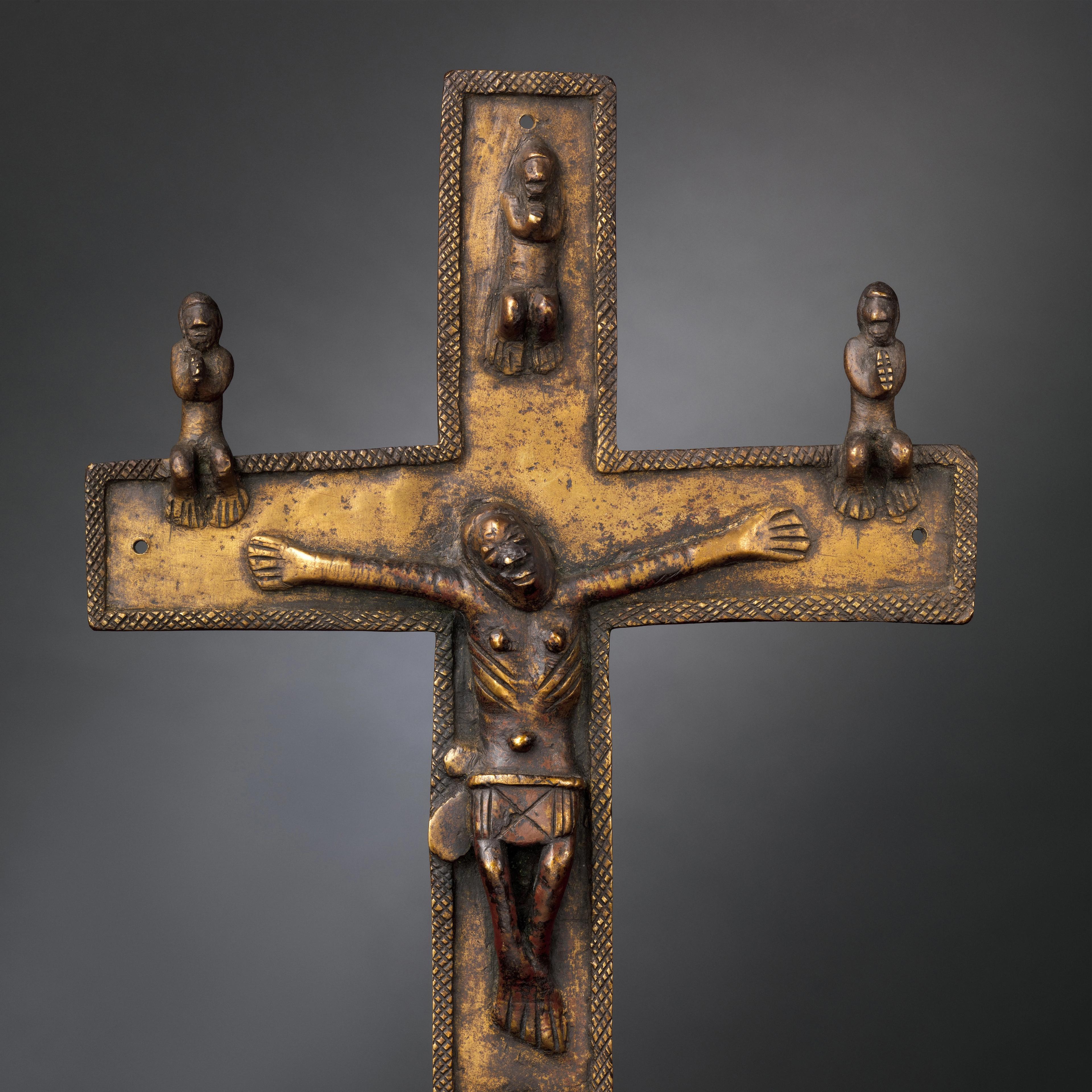When we look at Kongo Christian visual culture, we know there is an entire part of what it is showing, what it is doing, and what it is alluding to, that is not derived from the European version of Christianity. In that regard, in part thanks to them, we have a lot of documentation and a rich archive of deeply rooted local conceptions about the shape of the world and the cosmos. We have a rich understanding of the ideas that are encompassed with the cruciform motif that can take the form of a cross, a lozenge diamond shape, or many variations of this, through a set of objects that can be related to Christianity and are articulating that set of beliefs with the iconography of the Roman cross and the dying Christ.
These ideas are related to a cyclical conception of human life and, by extension, the universe in which birth and death are two critical but integrated points of a cycle that moves between the life that is visible and another life that is invisible. We have interesting descriptions of this moment in missionary texts where the missionaries are discussing with their Kongo interlocutors how to translate heaven or hell, which on the Christian side of things, is very much talking about that other side of what happens when you're not in the visible world. Their Kongo interlocutors are pushing against the idea of the Christian afterlife, in particular hell, where in one case they're asking the missionaries, "Well, how do you know about hell? Did anybody go there and come back and tell you about it? It's ridiculous. That is not what the other life is. The other life is more likely than not the same as here but on the other side, and then you'll come back."
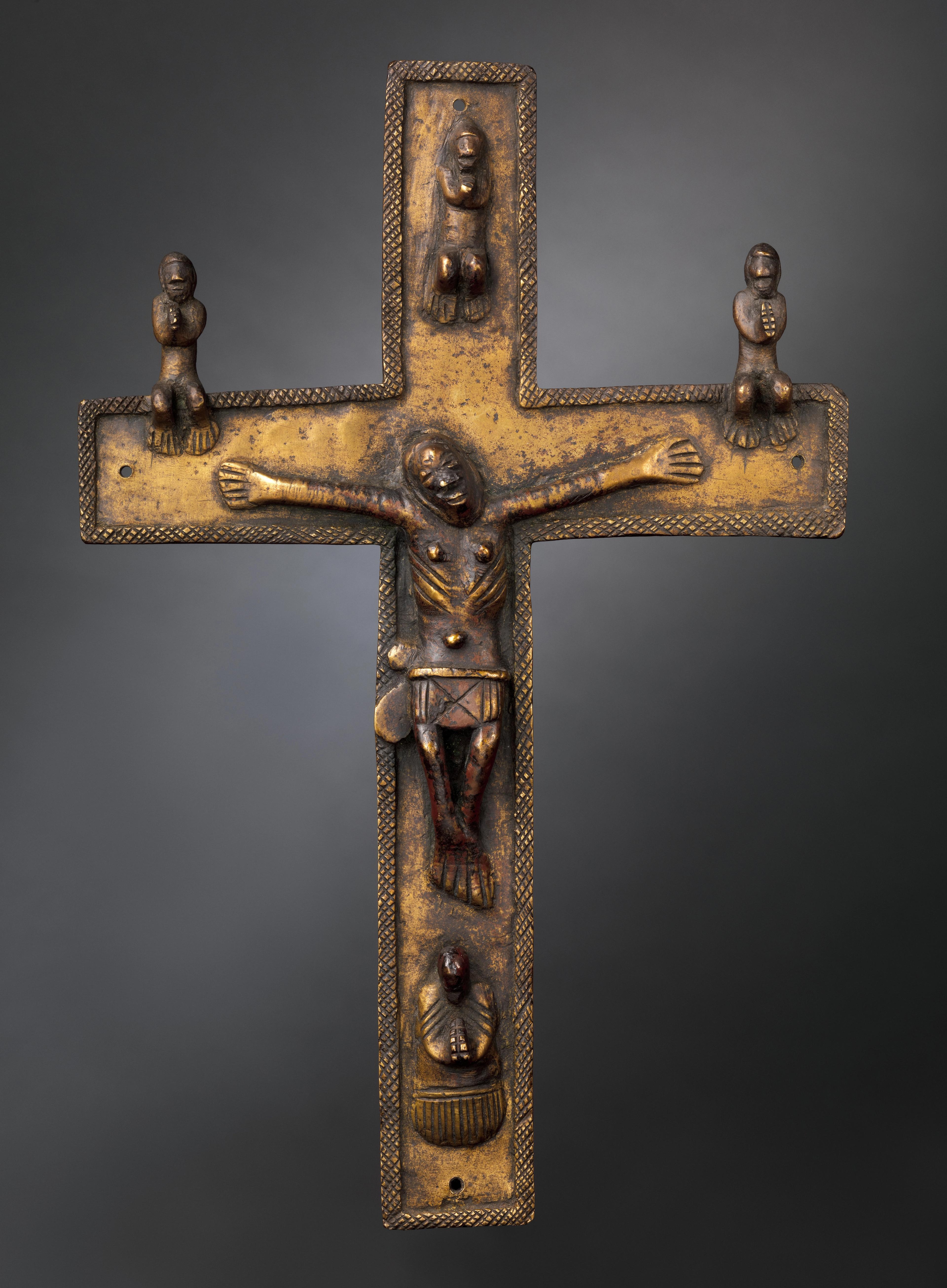
Kongo artist. Crucifix, 16th–17th century. Democratic Republic of the Congo, Angola, or Republic of the Congo. Solid cast brass, H. 10 3/4 × W. 7 × D. 3/4 in. (27.3 × 17.8 × 1.9 cm). The Metropolitan Museum of Art, New York, Gift of Ernst Anspach, 1999 (1999.295.7)
Here, we are looking at a quintessential, beautiful Kongo crucifix that is made of brass and includes a set of characters that are typical of the Kongo and its version of Christianity. At center, of course, is the body of Christ who is dead or in the process of dying with his head bent to the right. He is described in vivid ways that are not necessarily naturalistic, but we can see the weight of his body. The ribs on the side, his umbilicus, are marked very prominently as an important part of his anatomy. His arms are extended, and his legs come together at the feet as they would in European crucifixes, but there are no nails piercing his body. He is surrounded by three figures at the top and on the branches of the crucifix that have their hands joined together. They seem to be in prayer, and my interpretation is that they are figures trespassing between the realm of the living and the realm of the dead. They're suggesting perhaps souls in the Christian way of thinking and perhaps ancestors who have been dead and are crossing that barrier between life and death.
At the bottom of Christ is a figure of the Virgin. She's very abstracted, but we know it is her because of the moon shape at the bottom of her dress, which is a feature of images of the Immaculate Conception. This is very typical of representations of the Virgin in the Kongo from the seventeenth century on. She has textiles wrapped around her that are represented with lines on her shoulders and parallel lines on the skirt. She is present there, within the enclosing of the textile lines that go all around the crucifix, which hints at a very Kongo reading of that imagery. That crisscross line is referring to the kinds of textiles that would be used as funerary wrapping of people of high status. This crucifix is also a funerary bundle, and what is inside has trespassed and what is outside is still in the realm of the living. That's what makes those two figures on the branches so interesting because they are bridging the gap in a way that Christ does not. He is wholly enclosed within that textile barrier, dead.
If we think three-dimensionally, although it's a quite flat object, the figure at the top of the cross also challenges the idea of inside and outside because it protrudes far from the surface of the cross, while two-dimensionally he remains fully within the textile border. It is a sophisticated play on dimensions between the two-dimensional and the three-dimensional. The representation of time is key here because it is about the passages from life to death, and from death to life, through the story of the resurrection of Christ but also according to parallel Kongo ideas about the passing from life to death and back. The most clearly Kongo parts of the crucifix are the two moments that are about the idea of intersection, which is the key abstract concept behind the idea of the cross and cyclical life. It is about the intersection of these two worlds and marks this place of intersection as a space of fluidity and porosity between these two realms.
We see it in two places. The first is on the loincloth of Christ with the X-shaped cross clearly marked, which is the typical symbol of that idea of Kongo intersection, the Kongo cross, that by the twentieth century is richly interpreted by local knowledge makers and translators and local ritual practitioners as the Kongo cosmogram. The other moment where this is marked is the placement of the head of Christ at the intersection of the two branches of the Roman cross, which is something that one can only really see when having looked at many, many Kongo crucifixes. The head of Christ is almost always at that intersection of the two branches.
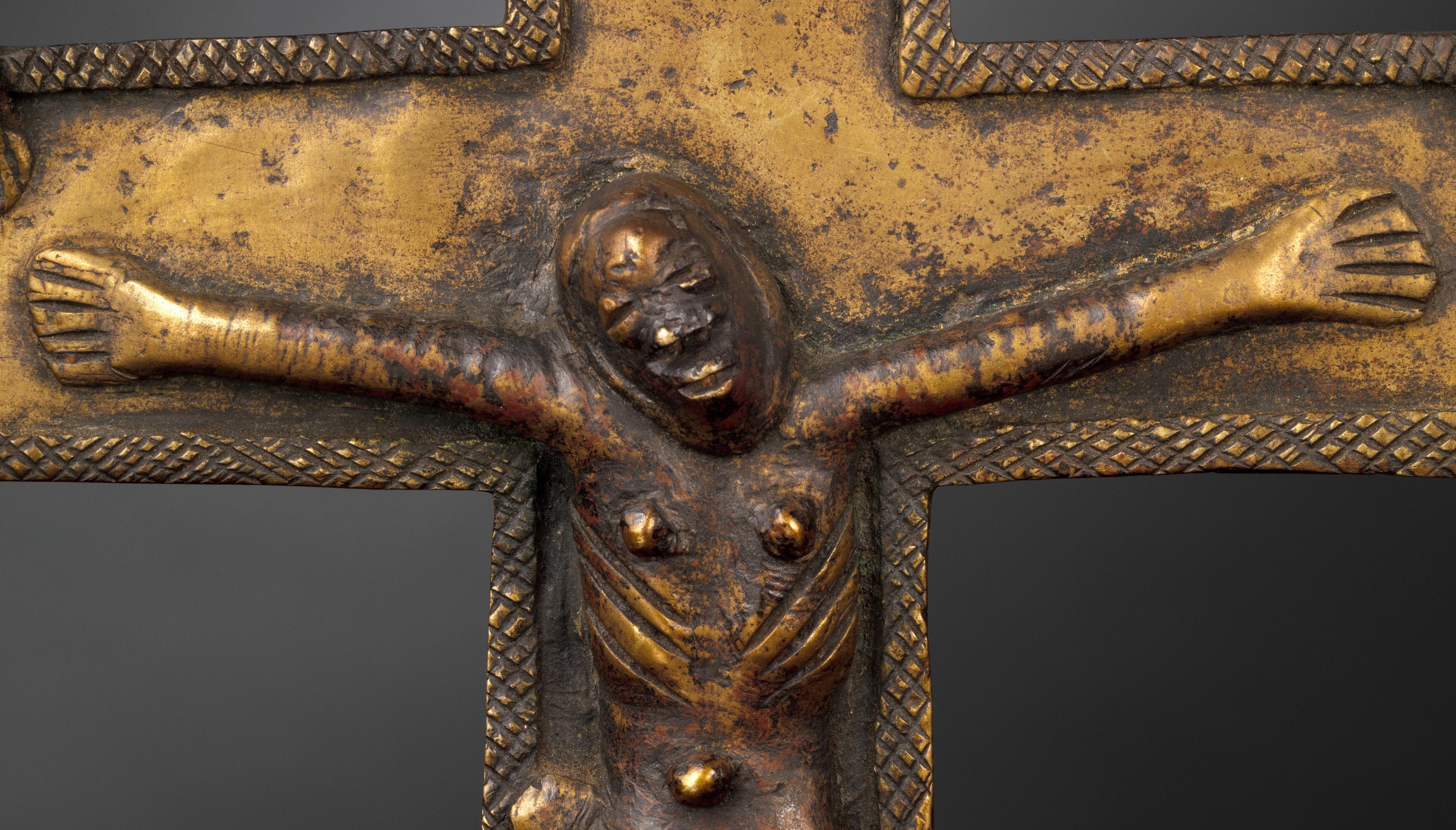
Detail of Crucifix
This artwork has subtle and powerful moments of iconographic rendering of this abstract idea of the Kongo cross: the intersection, the fluidity between life and death, that is making this crucifix—which is very much an illustration of the Christian story of life and death emblematized by the Roman cross—and putting it into conversation with the Kongo cross, another related but different idea of life and death and their circularity. In the production of this artwork, there is a deep dialogue between the visual traditions of Central Africa and the visual traditions of Europe. They are put together into an object that creates a new visual, material, and spiritual space. It echoes both sides and confronts them, merging them into an object of its own.
The early Christian history of the Kingdom of Kongo
The origins of the Kingdom of Kongo are still debated among scholars, but we know that it came together through a mix of wars of conquest from some kind of center that agglomerated other areas, and then alliances that brought together different, older kingdoms into a larger entity. The oral histories that were recorded in the sixteenth, seventeenth, and later centuries point to the thirteenth century as its moment of emergence—a key time when these processes of agglomeration formed a kingdom that would later be recognized as the ancestral origin of the Kingdom of Kongo.
Christianity arrived at the same time as the early Portuguese explorers, adventurers, and travelers that were exploring the coast of Atlantic Africa in the late fifteenth century. Clerics were part of these first expeditions. When they came to a new place, the practice of the Portuguese was to leave some of their people on that site, usually younger people, and then invite, kidnap, or take other people back to Portugal, willingly or unwillingly. That happened in the first voyages of the Portuguese to the Kongo so that a few years after the first contact, there were people from the Kongo who had learned Portuguese and were instructed by clerics in Portugal about the Christian faith who were able to serve as intermediaries between the European and the Kongo sides. Rather early on, sons of nobles would be among those ambassadors or students that would go to Lisbon and come back with some regularity. The missionary project quickly became a dialogue that relied, one, on multilingual actors, and two, on actors who became interested and learned in Christianity. When more missionaries came to the Kongo, the conversation about translation and about the nature of the doctrine could happen in a sophisticated way.
For reasons that we may never know, the King of Kongo decided to embrace Christianity and receive baptism in the late fifteenth century. For a few decades, it was not an enthusiastic welcome. One of his sons, however, who would become Afonso I of Kongo, was very interested in the religion and became learned in its doctrine. When his father died, a new king had to be chosen because the role was not hereditary. Afonso made his claim to the throne, in part, by calling upon that new religion and its powers that he was able to mobilize against his brother and other contenders who rejected Christianity. There was a set of battles and Afonso was victorious. Ideologically, he was able to create a story that presented his victory as a repetition of, on the one hand, a deep-rooted Central African foundation myth of a new king with a new philosophy and new technology who is able to bring his people together and make the country better, and on the other hand, the story of the Emperor Constantine who made a heathen empire Christian. He mixed the two, and that correlation of the two stories is the foundation of Kongo Christianity.
It's a story and a foundation myth that remained essential to the political legitimacy of the Kongo throughout centuries and then traveled to the Americas and became an important locus of political socialization among enslaved and free Africans of Central African descent. It continues today to be called upon as a place of sovereignty for the Black Atlantic at large.

Vili-Kongo artist(s). Tusks with Figurative Relief, ca. 1880–1890. Loango Coast region, Democratic Republic of the Congo; Republic of the Congo; Cabinda, Angola. Ivory, H. 26 1/2 x W. 5 1/2 x D. 2 1/2 in (H. 67.3 x W. 14 x D. 2 1/2 cm.) and H. 31 x W. 4 3/4 x D. 2 1/2 in. (H. 78.7 x W. 12.1 x D. 6.4 cm.). The Metropolitan Museum of Art, New York, Gift of Marian Malcolm, in loving memory of her husband, Daniel Malcolm, 2022 (2022.516.2 and 2022.516.1)
Kongo and the transatlantic slave trade
One of the concomitant trends that impacted the history of the Kingdom during the same centuries as the rise and the consolidation of Kongo Christianity is the rise and consolidation of the Atlantic slave trade. From the first moments of interactions with Europeans, it was clear that one of the currencies that the Kongo Kingdom and its elite could use for international trade was enslaved people. It began at a scale that was not so different from local modes of commerce and exchange of manpower and control of the populations. But over time, it took on proportions that were much bigger and that had a deep impact on the historical trajectory that the Kingdom and neighboring polities in Central Africa would take.
I don't think it’s productive to think about this process in terms of cause-consequence: that the slave trade created civil strife in the Kongo, or that civil strife was the opportunity that opened the door to the slave trade. It was, of course, much more complex, and as a matter of fact, both happened at the same time. The slave trade disturbed the political and social relationships that were active in the Kongo. But the Kongo's own political fragility, in particular around the transmission of the crown, was also a main and important factor in its weakening in the seventeenth century and its eventual demise later on in the nineteenth century. The two worked hand in hand, and to some extent, being Christian, being Catholic, allowed the kings of Kongo to have some protection for themselves and for their people against enslavement. In theory, the Europeans conceived of the transatlantic slave trade as something that should not capture already-Christian captives. Of course, it wasn't true in practice.
At the same time, one of the great legacies of the Kingdom of Kongo would be ironically through the slave trade and the displacement of millions of people coming from around the Kingdom of Kongo who had some familiarity or predisposition to understanding Christianity through the lens developed in the Kongo. We know about this through the development of Afro-diasporic Christianity in the Americas. In Brazil, in Latin America in general, and also in North America and the Caribbean, some of the rituals, practices, and imagery that we find in the Kongo have been recreated and remobilized by enslaved or free people who claim descent or a connection to Central Africa. The slave trade made the Kingdom of Kongo and its Christianity broadly impactful phenomena.
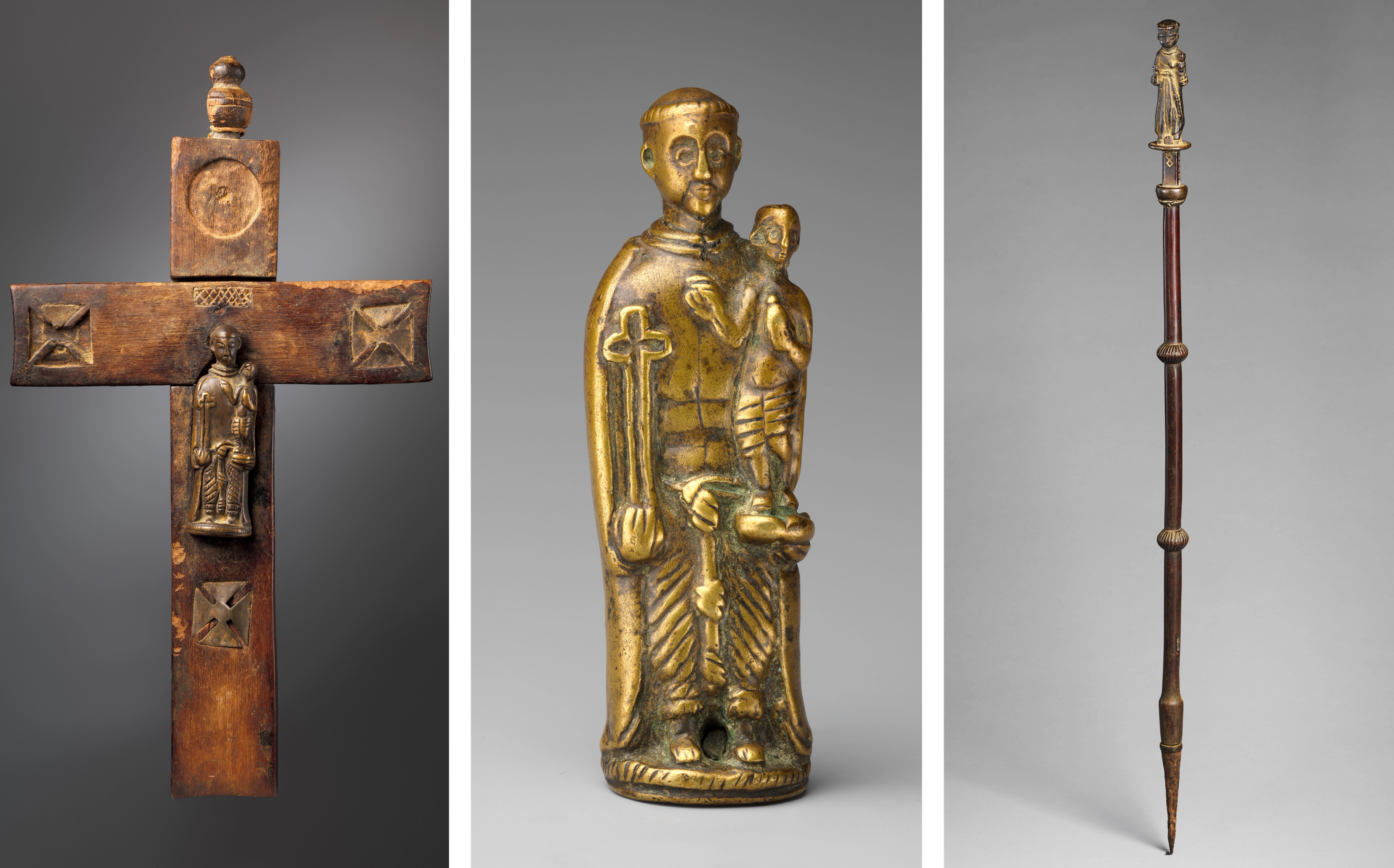
Left to right: Kongo artist. Crucifix with Saint Anthony of Padua, 16th–18th century (pendant figure), 19th century (cross). Democratic Republic of the Congo, Angola, or Republic of the Congo. Brass, wood, lead-tin alloy sheet, plant fiber cord, H. 12 3/4 × W. 7 1/4 × D. 17/16 in. (32.4 × 18.4 × 3.7 cm). The Metropolitan Museum of Art, New York, Gift of Ernst Anspach, 1999 (1999.295.14); Kongo artist. Pendant with Saint Anthony of Padua, 16th–19th century. Democratic Republic of the Congo, Angola, or Republic of the Congo. Brass, H. 4 × W. 1 3/8 × D. 1 1/8 in. (10.2 × 3.5 × 2.9 cm). The Metropolitan Museum of Art, New York, Gift of Ernst Anspach, 1999 (1999.295.1); Kongo artist. Staff with Saint Anthony of Padua, 19th century. Democratic Republic of the Congo, Angola, or Republic of the Congo. Brass, wood, iron, H. 41 1/2 × W. 2 × D. 2 3/8 in. (105.4 × 5.1 × 6 cm). The Metropolitan Museum of Art, New York, Gift of Ernst Anspach, 1999 (1999.295.2)
Metalwork in Central Africa
Copper, copper alloys, and brass featured among the imported materials that came from Europe into Central Africa, though the region also had deposits of its own. This cross could very well be made from imported brass from Europe and recast into an object that speaks to this interaction between Europe and Central Africa. The technique is open-mold casting in which a prototype would be placed on very fine sand or earth, then the imprint that it would leave would be cast with molten brass. Some of the crucifixes are made in different pieces and then put together on a wooden cross. Afterward, etching is added to the metal once it has been cast.
The person making this object would have been a trained specialist in metallurgy. For the Kongo, we don’t know much about this trade. We do know quite a bit about textile making, which was an elite practice, but for metalwork the historical sources—in particular, the written sources—are more silent. I think this has to do with the ritual modesty that was necessary for that practice, which is always filled with risk and danger and relies on a set of knowledge that has to be guarded. There is also the deep and insistent interest of Europeans in metallurgy that may have pushed the modesty further in terms of needing to protect the knowledge about the origins of metals in the region.
Metals are significant in the correlation between Christianity and Central African practices, and we see this in the creation of objects of Catholic forms that are made of brass. Those are the crucifixes and the saint figures, which we know were very important in the religious traditions of Kongo Christianity. They were also important in the political traditions as symbols of authority, legitimacy, prestige, wealth, and access to a long-distance network, both in terms of iconography—having these prototypes that would then be used—and the metal itself which was often imported from Europe.
The reinvention of Christianity and Kongo spirituality
I spent a lot of time thinking of ways to understand and describe the reinvention of Christianity and the Kongo worldview, the Kongo spirituality that we witness when we look at a Kongo crucifix, and when we think about the Kongo Christian Church. In the end, I took my cue from the crucifixes themselves and the ways in which they are bringing together different ways of thinking about space and time and articulating them into an object that is whole and present. You can also draw connections between the different elements in the object and traditions of spirituality, of aesthetics, and of symbology that are rooted in different areas.
This play of mixing and merging, but also arching back to different sources, is characteristic of Kongo Christianity in general. I like to think of it as a practice of correlation that brings together different elements, mixing them to create something new. Once it's brought together, because it is its own thing, it is whole. But it also has the power of changing those source elements that it brought together. Once you have Kongo Christianity, the perimeter of Christianity is changed. And once you have Kongo Christianity, Kongo cosmology has changed. It works both ways. The creative power of this correlation is what makes Kongo Christian artworks so compelling and so powerful visually and intellectually.
Hear from Cécile Fromont in the Arts of Africa Audio Guide.
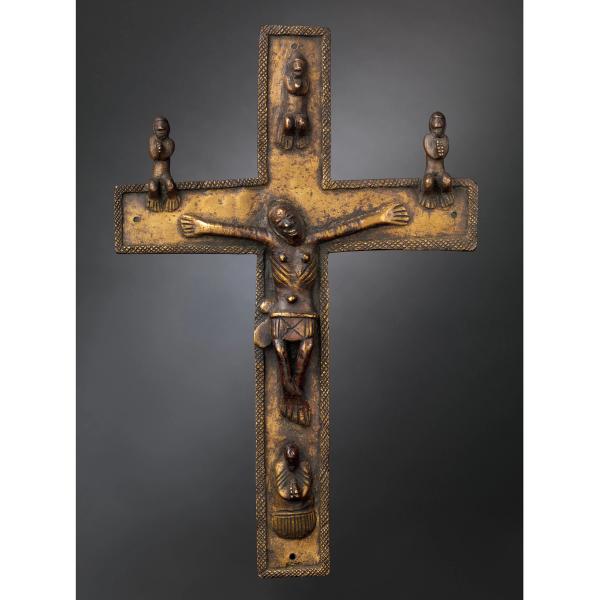
1546. Crucifix, Kongo artist
Cécile Fromont
CÉCILE FROMONT: We are looking at a quintessential, beautiful Kongo crucifix that is made of brass and includes a set of characters that are really typical of the Kongo and its version of Christianity.
I am Cécile Fromont, and I'm a professor of the History of Art and Architecture.
ANGELIQUE KIDJO (NARRATOR): Christianity arrived in the Kingdom of Kongo along with the Portuguese in the late fifteenth century. The king embraced this new religion, tying Christianity to the political and elite classes while others continued to practice their indigenous spirituality. This resulted in a blend of the two in the material culture, such as you see in this crucifix.
CÉCILE FROMONT: There is, of course, at the center the body of Christ. He is surrounded by four figures that have their hands joined together. My interpretation of them is that they are figures trespassing between the realm of the living and the realm of the dead. So they’re suggesting perhaps ancestors who have been dead and are crossing between life and death.
At the bottom is a figure of the Virgin. And she has textiles wrapped around her represented with some lines on her shoulders and skirt. And that is referring to the kind of textile that would be wrapped around bodies of dead important people. So this crucifix is also a funerary bundle and what is inside has trespassed and what is outside is still in the realm of the living.
ANGELIQUE KIDJO: As Fromont noted, Kongo practitioners undertook a customization of Christianity.
CÉCILE FROMONT: We have interesting descriptions of missionaries discussing things like how to translate heaven or hell, which are very much about that other side of what happens when you’re not in the visible world. And their Kongo interlocutors are pushing against the idea of the Christian afterlife, where they’re asking the missionaries, ‘Well, how do you know about hell? It’s ridiculous. That is not what the other life is. The other life is more likely than not the same as here, but on the other side and then you’ll come back.’
This essay is adapted from an interview with Cécile Fromont that took place in 2024 as part of collaborative research for the new Arts of Africa galleries in the Michael C. Rockefeller Wing.
